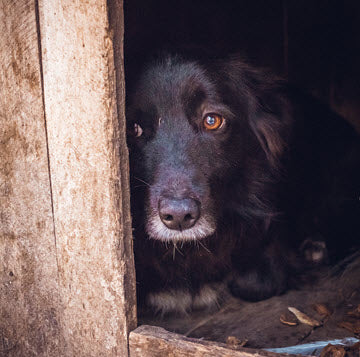Does your dog shy away from anyone and everyone, including you? Some dogs are so fearful they don’t even trust the people trying to help them. It can be an emotional challenge, but patience and understanding can go a long way toward building a mutual trust and bond with your “scaredy dog.”

Dogs can be afraid for many reasons. Under-socialization when they were young can make the world seem big and scary. Others may have had traumatic experiences along their journey. And some dogs may even have a genetic predisposition for shyness or fearfulness. Whatever the reason, don’t give up hope. Understanding the steps below can help make your dog feel safe and secure.
Trust
The first step is building trust between you and your dog. All dogs will react on their own timeline, but respecting his comfort zone and personal space is important. You would think that giving him more attention, touching him and talking to him would help him relax and bond, but it can actually make him more afraid. Instead, start by removing the pressure for him to react to what you want. By moving away and/or disengaging from interaction, you can make your dog feel safer and open the door to building trust.
Start by bringing your dog to a quiet room in your house so he can explore and get acclimated. Show him where to eat and sleep and then leave him to explore on his own. Give him more space and less attention and wait until your dog starts becoming interested in you.
Predictability
Define a set schedule for your dog and stick to it. A predictable routine may help him settle down. Knowing when and where he will eat and sleep, when it’s time to go out and when and how he will engage with others in the house may start to calm him down. Consistency can help lessen the stress hormones that are pulsing through a scared dog’s body. Repeated actions done in a calm, kind, non-confrontational manner is another step toward building trust.
Patience
You want your dog to be happy, calm and relaxed. But it can only happen on your dog’s timeline and cannot be rushed. A lot of patience is needed during this process. But in time you may see signs of progress – curiosity when you are making dinner, coming out of his safe zone more often, interacting with you when you get home. These can all be indicators that your dog may be ready the next step.
Connection
Most dogs find comfort in a gentle belly rub or a massage behind the ears. Start by giving your dog some tender touches. Hopefully he will derive pleasure and welcome your attention. But move slowly toward full hugs and playing with toys. Baby steps!
Training can also help build a relationship with your dog. It opens up communication and builds on your connection. Once he figures out there is a treat for doing the right thing, he will keep trying to figure it out. And when that happens, it will also build his confidence in connecting with you.
Conditioning
When a dog learns to associate one thing with another, it can be a productive tool for fearful dogs. For example, when he sees you put on your shoes and coat and grab the leash, he knows you’re going to go for a walk. You can also use counter-conditioning to help him stop the fearful response he exhibits to a certain action. An example of this would be if your dog crouches down when you walk by. Try dropping a small treat each time. Your dog’s response will begin to shift from being fearful to feeling good. Just be sure to go slowly so they don’t revert due to overload.
Activity
If you have another dog in the house, the resident dog may be able to show the fearful dog that you are in fact a safe person. By engaging them both in activities like walking together, training together, hanging together and playing together, your frightened dog may start to relax and loosen up. He will start to see you as part of the pack.
Play can also be a bond builder. Start with a stuffed animal or ball on a rope and steady, small movements. Sudden actions may cause him to retreat. Let your dog “win” frequently, even if it is just for moving closer to the toy. After a while, your dog will enjoy playing with you, and your relationship will grow.
New Conditions
There are many circumstances outside your house that may trigger a fearful response – a loud truck, new people, unfamiliar dogs. By slowly integrating these new adventures into your dog’s day, you can build his confidence. Watch carefully to see your dog’s response. Try to protect him from becoming overwhelmed, but don’t become too overprotective. Encourage exploration with new environments and other dogs. Every positive encounter will make him more brave for the next new experience.
Every hurdle your dog overcomes will add to his success and happiness. And every new sign of happiness in your dog will fill your heart with joy and fulfillment.
This blog is brought to you by Under the Weather®, provider of bland diet products for dogs. These bland diet products offer a quick and convenient solution when dogs experience digestive issues such as vomiting or diarrhea. Ready to go in minutes – just add boiling water to rehydrate.
Our bland diet recipes are made with 100% human-grade meats – no meat by-products, antibiotic free and no hormones added! They are gluten free and have no chemicals or dyes. Sourced and manufactured in the U.S.A.
View Our Products
Visit Our Blog Library




